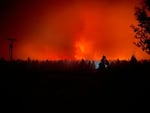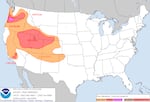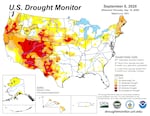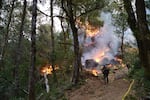
The sky glows red as the Two Four Two Fire burns in the distance in this image taken overnight Sept. 7-8, 2020 outside Chiloquin, Ore.
Evan Wright/Fremont-Winema National Forest
Jay Stockton’s desk job is not the kind you do from home during a pandemic. So on the first of a four-day fire weather shift at the National Weather Service in Medford, the senior forecaster went into the office, sat down in front of his five monitors and started watching the satellite and radar data roll in.
“It was evident early on that we had an anomalous event coming up,” Stockton said.
It was the Friday going into Labor Day Weekend.
Stockton is used to fall weather patterns in southwest Oregon that create east winds. There’s even a name for what happens: “the Chetco Effect.” If the wind direction is just right, cool air drops down into the Chetco Canyon, warming as it descends toward the ocean. The winds pick up speed as they funnel down the canyon. Then they hit the coastal town of Brookings with a wall of hot, dry air.
“When you get the wind combined with very low humidity, that is a bad combination,” he said.
What Stockton saw that Friday was similar — except it was going to hit most of southwest Oregon. Northwest Oregon wasn’t going to be spared either. On top of this, humidity levels were going to be extremely low.
The next day, Stockton and his office issued a series of Red Flag Warnings. Then Sunday, the NWS Storm Prediction Center forecast an area of “Extremely Critical Fire Weather” around Salem for Monday and Tuesday — the first time those conditions have ever registered in western Oregon.
Stockton has seen all kinds of wind events during the 22 years he’s worked in Medford as a weather service forecaster.
“Not like this,” he said pausing slightly to let it sink in. “Not like this. I’d never seen this before.”

On Sunday before the fires, the NWS Storm Prediction Center forecast an area of "Extremely Critical Fire Weather” around Salem for Monday and Tuesday — the first time those conditions have ever registered in western Oregon.
NWS Storm Prediction Center
What followed will likely go down in Oregon history as its most intense wildfire event ever recorded: dozens of fire starts between Monday and Tuesday with the winds driving the flames quickly across the landscape. Thousands of homes and structures burned. The wind event that spanned those two days is already responsible for nearly a million acres burned in western Oregon — and the fires still aren’t out.
But climate scientists aren’t dismissing the scope of these fires as a windy act of God or a fluke of nature. One of the big questions following Oregon’s 2020 wildfires will be: Just how many links are there to human-caused climate change?
The setup
While Oregon hasn’t seen this kind of wildfire season before, it’s not exactly unfamiliar — especially as climate change plays out.
“It fits into a many-year western United States pattern of more fires. More large fires. More destructive fires,” said Erica Fleishman, director of the Oregon Climate Change Research Institute at Oregon State University. “And all of that is consistent with what climate scientists and ecologists and others have been projecting for decades.”
Indeed, this has been the refrain from climate scientists for years, something broadly accepted by political leaders in the Pacific Northwest and California, although largely denied or ignored by the Trump administration.
“This is truly the bellwether for climate change on the West Coast,” Oregon Gov. Kate Brown told CNN. “This is a wake-up call for all of us that we’ve got to do everything in our power to tackle climate change.”
Related: What role is climate change playing in this year’s historic wildfire season?
The scientific evidence is clear that burning fossil fuels sends carbon dioxide and other gasses into the atmosphere. Trapped there, they cause global temperatures to rise.
And one of the most direct consequences of climate change is drought — a condition emerging as part of Oregon’s “new normal” and a stage-setter for the recent wildfire event.
When the fires hit Oregon, about a quarter of the state was experiencing “extreme drought,” with much of the state west of the Cascades under those conditions. More than 80% of the state was under “moderate drought” or worse.
Since 2000, there’s only been one year (2006) that Oregon has not experienced at least moderate levels of drought. And in only four of these years did Oregon not have severe drought.
“Drought certainly contributed to the fires that we’re seeing now,” Fleishman said.

About a quarter of Oregon was experienceing extreme drought conditions as large wildfires spread across the western part of the state.
United States Drought Monitor / OPB
Under drought conditions, plants and trees have less available moisture, creating dry fuels that burn readily during wildfire. Drought conditions can also stress trees, which are then more likely to succumb to insect infestations. Trees die. And dead trees burn.
Drought conditions are linked to climate-driven temperature increases across wide swaths of the western United States. According to the National Climate Assessment, the Northwest has seen a rise of more than 1.5 degrees Fahrenheit in the average annual temperature. Northwest winters are warming faster than our summers, meaning the precipitation is increasingly falling as rain instead of building the snowpack. Less snowpack means less water flowing out of the mountains in the summer, triggering drought and drying out our forests earlier.
Multiple years of drought compound the problem.
“Maybe you never have reason to think of the upper couple meters of soil, but it’s actually quite important,” said Oregon State climatologist Larry O’Neill.
If you want to recharge groundwater supplies that humans and ecosystems rely on, rain and snowmelt need to seep down through the upper layers of soil. During droughts, that moisture in the soil and in the groundwater gets depleted slowly, without enough new moisture to replace it.
“So over many years, it just slowly deteriorates,” he said.
And so, with that kind of moisture-deprived soil and vegetation in western Oregon going into Labor Day weekend, O’Neill said, “it’s like someone poured gasoline on the forest.”
Winds of climate change are blowing
The connection between drought, temperature and climate change in the West is well-established. But what about the anomalous wind event that set Oregon’s fires in motion?
“I do think that there is a connection with climate change. Climate change will alter circulation patterns globally, so it’s not unreasonable to expect,” O’Neill said. “It’s just getting at some of the details of exactly where and how that’s occurring that maybe we still don’t know.”
This question pushes up against the leading edge of climate science, and a theory that seeks to explain the increase in severe weather events in North America — from heat waves to extreme cold snaps to rapid and radical weather swings and, further down the line of cause and effect, potentially even high wind events.
“It’s really all about getting ready for the future and understanding what kinds of extremes we’re going to be facing in different parts of the world,” said Jennifer Francis of the Woodwell Climate Research Center in Massachusetts.
The extremes in weather can be connected to the jet stream, a high-altitude river of air that circles the globe. The jet stream that matters for Oregon flows west over the mid-latitudes of the Northern Hemisphere. It has the ability to influence local weather conditions because it forms the boundary between and can push around high- and low-pressure systems. When the jet stream flows fast, it’s relatively flat. But when the air currents lose speed, the jet stream gets wavy. This is when extreme weather events often happen.

As Labor Day approached, the jet stream started to dip down and helped funnel the unususal weather system that brought high winds and major wildfires across Oregon.
San Francisco State University
When the powerful wind event hit Oregon on Labor Day, the jet stream wasn’t just wavy, the slope was becoming steeper than the Cascades themselves. The jet stream over the Pacific Northwest dipped south, and the air flow helped steer the unusual weather system that caused the extreme winds down into Oregon.
Climate scientists want to know what causes the jet stream to become wavy and if we should expect these extreme weather events more often in the future as global temperatures continue to rise.
Back in 2012, Francis first put forward the wavy jet stream hypothesis, saying that climate change-triggered warming in the Arctic is causing jet stream winds to slow down.
Since then, dozens of scientists have been trying to test this.
“It is still a very active research topic, but the evidence is piling up that we are seeing this connection between the rapid warming in the far north and tendency for these wavy patterns to happen in the jet stream that can lead to these long-lived weather conditions,” she said.
But she acknowledges it’s difficult to test because the physics of our atmosphere, the warming happening in the Arctic, and interplay between the two are extremely complex. Francis says different climate models yield varying results when trying to show and predict the effect of climate change on the jet stream in the future.
In February, a paper out of the United Kingdom found the warming Arctic was not increasing the waviness of the jet stream.
But much of the research coming out suggests links that connect global warming to changes in jet stream behavior and extreme weather events, including those in Oregon.
Penn State Earth System Science Center director Michael Mann estimates the number of these wavy jet stream events will increase by 50% by the end of the century if the current climate change trajectory remains the same.
“Most of the truly unprecedented extreme weather disasters we’ve seen in recent summers throughout the Northern Hemisphere — the floods and heatwaves and droughts. Most of them … have been associated with these resonance [wavy jet stream] events,” Mann said. “And they are getting more frequent because of human-caused planetary warming.”
While it’s generally scientific folly to attribute any single extreme weather event directly to climate change, Mann says to think of the situation like someone who comes down with lung cancer after a lifetime of smoking.
“You can’t prove any one cigarette led to the lung cancer, but you know all of them contributed. It’s sort of the same thing here. It’s probabilistic,” he said.
And while the sinews connecting Oregon’s Labor Day wind storm and climate change are far from being firmly established, it’s safe to say extreme weather events — many of which increase wildfire risk in the state — are likely to increase in frequency in the coming decades.
The ghosts of climate future
Eventually, enough rain will fall to quench Oregon’s fires. The 2020 fire season will be behind us and we’ll assess the damage and start to rebuild towns and homes.
Related: Why a blast of rainfall on Oregon’s new forest fire scars could trigger landslides
In the forests that burned, a different kind of recovery will begin — the process of regeneration. And here, too, a changing climate will shape our landscape.
Kerry Kemp, a forest ecologist for the Oregon Nature Conservancy, studies forest resiliency, or the ability of forests to come back after wildfire or other major disturbance.
For new trees to grow in the forest, living ones must be nearby to act as a seed source. And then once those seeds start growing, they’re more susceptible to drought than established trees.
“The resilience of these forests is likely to be lower when there’s a mismatch between the current climate and the climate niche for tree regeneration,” Kemp said.
As the climate changes, a given location may no longer be capable of supporting tree regrowth the way it could when temperatures were lower and weather patterns were different. In some parts of the West, it’s already happening, she said.
This likely won’t be a concern for the Cascade range forests east of the Willamette Valley. Conditions remain suitable for the regrowth of dominant species like Douglas fir. Kemp says the issues arise on the edges.
“This is especially true in places that were marginal for forest occurrence or on the edge between forest and woodlands or grasslands, savannah-type ecosystems prior to the fire,” Kemp said, adding that in these places the ecosystem transitions could already be underway as a result of climate change and are just expedited by fire.

A firefighter monitors a burnout in the Chetco Bar Fire, Tuesday, Sept. 19, 2017.
Andy Lyon / via InciWeb
Melissa Lucash, a forest researcher at the University of Oregon, has studied how trees regrow after fire in the Klamath region. She found that Douglas fir came back regardless whether they were replanted or left to return naturally.
“Ponderosa pine, you could tell the difference. Ponderosa pine really benefited from the additional planting,” she said. “So if you’re interested in diversity and capturing lots of species, some of which might not be as drought tolerant, then planting was more successful and helpful.”
And overall, the outlook for the forests of the Klamath region even before the fires wasn’t encouraging. Based on her research, at the current rate of warming under climate change, Lucash expects 30% of the dry forests of southwest Oregon and Northern California will transition to shrubland.
Depending on what the goals for the land is — whether it’s being managed for habitat, recreation or clear-cut logging — it may not really matter what comes back after wildfire. But if reestablishing forests for the long haul is desired, climate challenges could require more intense and sustained intervention from humans than it would have even 30 years back.
And ultimately the forests of Oregon’s past could look very different from the forests of our future.
